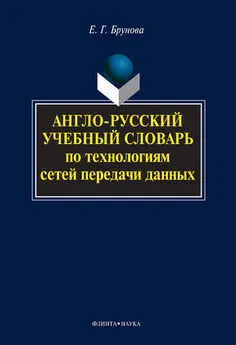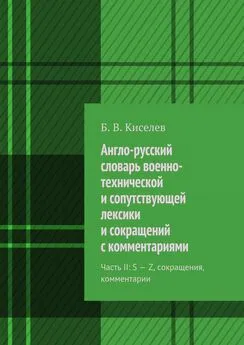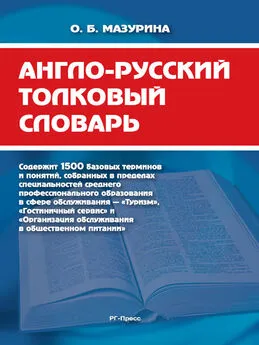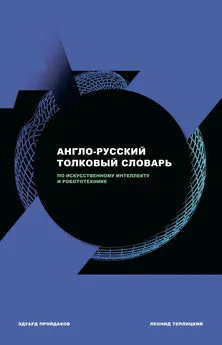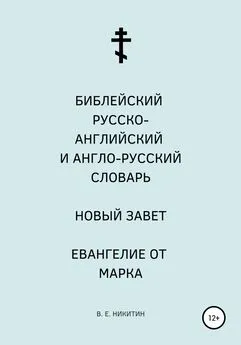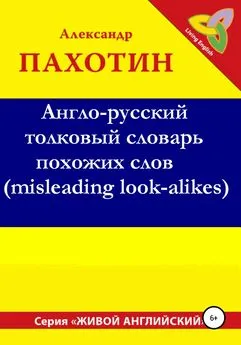Е.А.М.Уилсон - Англо-русский учебный словарь 1984
- Название:Англо-русский учебный словарь 1984
- Автор:
- Жанр:
- Издательство:неизвестно
- Год:0101
- ISBN:нет данных
- Рейтинг:
- Избранное:Добавить в избранное
-
Отзывы:
-
Ваша оценка:
Е.А.М.Уилсон - Англо-русский учебный словарь 1984 краткое содержание
Англо-русский учебный словарь 1984 - читать онлайн бесплатно полную версию (весь текст целиком)
Интервал:
Закладка:
In groups of cognate words, such as biological, biologist, biology, one or more of the terms may be omitted. Similarly English words which are translated by direct transliteration into Russian are often omitted, e.g. morgue морг, or nymph нимфа. In such cases it will be easy for the student to form or find these for himself.
THE LANGUAGE
Emphasis has been given to the spoken language—both everyday colloquial uses and more specialized uses, e.g. the' language of the committee man. Many of the examples are given in the second person singular indicating exchanges between friends of the. same age, or colleagues of the same rank, or members of a family. A strong distinction is made between colloquial expressions and slang, the latter being included only if it is well established, partly because it can date so quickly, partly because it is hard to appreciate its exact tone in a foreign language. Translations are as far as possible stylistically matched. Where there is no true equivalent of an English expression such as ghost writer, it has seemed better to omit the term rather than to offer explanations or cumbrous circumlocutions, which the student could equally well form for himself if need arose.
ILLUSTRATION
Translation by single words seldom enables the student to use these words in a living context. The illustrations are designed to provide such a context. They also show the difference between the two languages in construction and grammar where rules apply. For example, translation of the English predicative adjective does not always in Russian follow directly from the attributive form, e.g. unconnected sentences несвязные фразы, but the two events are quite unconnected эти два события никак не связаны между собой.
Illustrations also serve to familiarize the student with Russian word combinations and word order, and with the typical flow and rhythm of the Russian sentence, none of which can be deduced a priori. Though word order in both languages is flexible, varying according to emphasis, nevertheless there are standard patterns of order where the two languages differ, e.g. she walked in her sleep last night сегодня [NB] ночью он ходйла во сне. Again the invariable English cadence is supply and demand, but the Russians prefer спрос и предложение.
LAYOUT
All English words and phrases are printed in bold type. Indicators (of style, meaning, etc.) are printed in italics. Long entries are divided; each division is numbered, begins on a new line and is inset. But short entries which can be taken in at a glance, may contain no divisions, even when these would be justified semantically.
ORDER WITHIN AN ENTRY
Usually an entry or division starts by giving one or more general translations. Examples then follow grouped around the general translations in the order in which these were' given; then come examples which are not covered by any of the general translations.
Within an entry or division, direct uses are given first, followed by specialized, colloquial direct, figurative and then figurative colloquial uses. In big entries figurative uses are often treated in a separate division. Attributive uses of a noun come at the end of the entry or of the appropriate division.
The divisions of an entry normally depend on the different shades of meaning in which the English headword is being used, but, exceptionally, divisions may be given over to translations of a single English meaning by particular Russian constructions, if it seems that to do so will make for a clearer understanding by the English learner.
Transitive and intransitive uses of a verb are treated separately. In the case of the larger verbs, uses with prepositions or adverbial particles are given separately as headwords in alphabetical order, and they are similarly divided into transitive and intransitive uses.
TRANSLATION OF HEADWORDS
A number of entries open with a colon and proceed straight to the examples. This happens when no sufficiently general translations of the headword suggest themselves. A translation which only suits one use of the headword is always shown in context: it is misleading to give one-time uses in a way that suggests that they can be widely applied.
Again Russian definitions or explanations of the headword are avoided. The student is looking for Russian equivalents usable (when properly inflected) in live context. To translate some (pronoun ) by некоторое количество is an explanation, and it is most unlikely to be the correct translation of some (pronoun) in any given context. Again приветствие is a correct translation of welcome (noun), but, in the four common examples chosen in the text, it is not used once. In such a case the student is less likely to be misled if the entry opens immediately with translations of the common contexts, or of the set combinations in which the headword is normally used.
GRAMMATICAL INDICATIONS
Each headword is followed by its grammatical label in abbreviated form: n — ndun, adj —adjective and so on.
The constructions following a Russian word are always shown, either in abbreviated form, e.g. любовь к + А привыкнуть к + D or+ inf, or they may be shown in examples, and often in both ways.
A number of explanatory notes on grammar and construction are provided in square brackets; or the student's attention may be drawn to an unexpected usage with an NB in square brackets.
Knowledge of the aspects of Russian verbs is of such fundamental importance that, even at the cost of much repetition, aspects are noted in all verb entries.
Inflexion and changes of stress are shown for numerals and pronouns which are one-time entries. Otherwise these are not shown, as a Russian word may recur in many entries and repetition of the information under each entry or cross-referencing would alike be uneconomic.
STYLISTIC AND FIELD LABELS
Stylistic and field labels are given in italics without brackets, thus: joc —jocular, fig —figurative, CQ —colloquial. Field labels begin with a capital letter, thus: Bot —botany, etc. The indication is given immediately after the headword if it applies to the whole entry, otherwise just in front of the appropriate part of the entry. Specifically British, American or Russian uses are marked (UK), ( US) or (SU) respectively.
INDICATORS OF MEANING
Indicators of meaning are given in italics and round brackets where necessary, to show in which sense an English word or phrase is being used, or which sense of the headword a division covers. E.g. affect vt 1 (influence)...
(move)...
(pretend)...
Indicators are also used to differentiate between shades of meaning where more than one Russian translation is offered, e.g. deliberately adv (on purpose) нарочно, преднамеренно; (slowly) неспешно; (cautiously) осторожно.
Translations which are synonyms or "near synonyms" are divided by a comma; if they differ more widely by a semicolon. However, true synonyms are very rare, and every effort has been made to differentiate shades of meaning of Russian words, not only by indicators, but also by examples. Where one or more of the "near synonyms" may be used in an example as alternatives, these are shown.
NOTES FOR USERS
ORDER OF THE ENTRIES
Strictly alphabetical order is followed. Grammatical homonyms of words related in meaning are distinguished by their grammatical labels, and are treated as separate headwords in the following sequence: noun, adjective, adverb, preposition, verb, thus: round n round adj round* adv round prep round vti
Homonyms of different meaning are distinguished by superior numbers and treated in the same sequence, in the order of their Superior numbers, thus: fasti nR ei fast 1 vi
fast 2 adj (firm) fast 2 adv fast 3 'adj (quick) fast 3 adv
PRONUNCIATION
Phonetic transcriptions of English words are not given. Russian pronunciation is indicated by stress marks. Alternative stresses are marked only if both stresses are in current use.
USE OF THE TILDE
The tilde sign stands for the whole English headword when repeated in an entry, thus: face л...; ~ to ~ лицом к лицу (= face to face); correct v/...; the teacher ~ed my essay... (= corrected).
USE OF THE HYPHEN, AND OF THE HYPHEN PLUS VERTICAL STROKE
In showing the perfective aspects of Russian verbs, a hyphen, when preceded by a prefix, represents the full Russian perfective, thus: писать (на-) (= написать).
With Russian words divided by a vertical stroke, the hyphen represents that part of the word which is to the left of the stroke, thus: получ|ать (-йть) (= получить); комсомолец, /-ка (= комсомолка).
A stress mark over the hyphen indicates shift of stress to the syllable immediately preceding the vertical stroke, thus: вставлять ( :ить) (= вставить); выполнять (-полнить) (= выполнить); проверить ( :ить) (= проверить).
USE OF BRACKETS
If a word in either English or Russian is enclosed in round brackets but is not in italics, it means that that word may be omitted without detriment to the sense of the phrase.
Round brackets are used to enclose the aspectival forms of Russian verbs. Russian italics are not used.
Round brackets in conjunction with (English) italics are used:
to enclose indicators of meaning;
to enclose abbreviated grammatical indications; e.g. to draw attention to a Russian singular used to translate an English plural or vice versa: variations In price изменение (sing) в ценах (pi); or to note the Russian use of an impersonal verb: I feel sick меня тошнит (impers) ; or to note the use of a Russian adverb to translate an English noun or adjective: in the vicinity of the station поблизости от/вблизи (advs) вокзала; etc.
Square brackets in conjunction with (English) italics are used for brief editorial comment, e.g. to enlarge on a point of grammar, or a construction. They are also used with an
NB to draw attention to an unexpected usage in Russian, e.g. to bake a lot of pastries напечь пирожков [NB use of prefix]; the market is buoyant торговля оживилась [NB tense].
INDICATING ALTERNATIVES: THE DIAGONAL STROKE, THE COMMA AND "OR"
The diagonal stroke is used:
to show different combinations which may be used with the headword and in the corresponding translations, thus: to get an answer/permission/a prize/recognition/a scolding получить ответ/ разрешение/ приз/ признание/ выговор;
to show possible alternatives within a phrase in one language only, thus: the casting/ deciding vote решающий голос; various forms of transport разные /различные виды транспорта.
Читать дальшеИнтервал:
Закладка:


